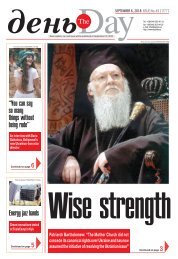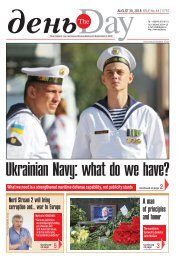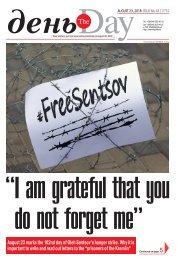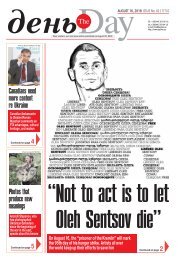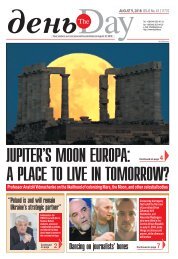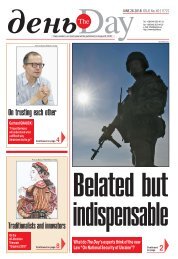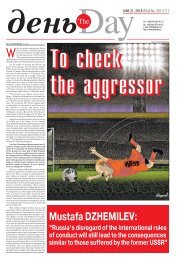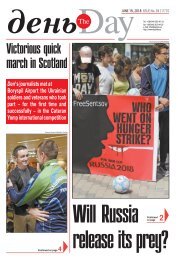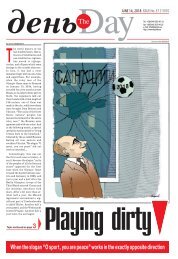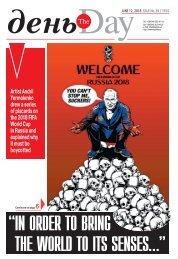#47_1-8
Create successful ePaper yourself
Turn your PDF publications into a flip-book with our unique Google optimized e-Paper software.
6<br />
No.47 SEPTEMBER 20, 2018<br />
SOCIE T Y<br />
WWW.DAY.KIEV.UA<br />
Photo by Mykola TYMCHENKO, The Day<br />
IhorPASICHNYK:<br />
“Den provides a powerful<br />
intellectual milieu”<br />
The rector of Ostroh<br />
Academy discusses changes<br />
in the education sector and<br />
new horizons of cooperation<br />
with his favorite publication<br />
By Oleksii KOSTIUCHENKO, Ostroh<br />
Den/The Day has cooperated with<br />
the National University of Ostroh<br />
Academy for 15 years. During this<br />
time, we have managed to implement<br />
many joint initiatives, including the<br />
Ostroh Club of Free Intellectual Communication<br />
for Youth which grew into<br />
an international project called the<br />
Ostroh Forum last year, a series of discussions<br />
which editor-in-chief of this<br />
newspaper Larysa Ivshyna has held<br />
with students, as well as students attending<br />
Den’s Summer School of<br />
Journalism. In addition, Ivshyna<br />
serves as co-chair of Ostroh Academy’s<br />
Supervisory Board. At the beginning<br />
of the new academic year, we<br />
discussed with the school’s rector,<br />
Hero of Ukraine, Professor Ihor Pasichnyk<br />
results of the 2018 admissions<br />
campaign, implementation of education<br />
reforms, and new horizons of<br />
cooperation between Den/The Day<br />
and Ostroh Academy.<br />
● “OUR FRESHMEN COME<br />
FROM ALL REGIONS OF<br />
UKRAINE, INCLUDING<br />
KYIV”<br />
Professor, we know that Ostroh<br />
Academy admitted almost 500 freshmen<br />
this year. What can you say<br />
about this year’s admissions campaign?<br />
“Despite the demographic shortfall,<br />
we have successfully completed<br />
the admissions drive, especially in the<br />
leading educational and professional<br />
programs of Ostroh Academy, which<br />
are international relations, law, Germanic<br />
languages and literatures, and<br />
journalism. Also, we launched an educational<br />
and professional program in<br />
computer sciences this year, which<br />
applicants have been enthusiastic<br />
about. Each university has its own<br />
applicants, and therefore they know<br />
where they apply and what they will be<br />
required to do when studying. I am<br />
pleased to see that Ostroh Academy<br />
freshmen come from all regions of<br />
Ukraine, including Kyiv. Most importantly,<br />
we have admitted a highquality<br />
bunch of young people, because<br />
our freshmen are mostly<br />
straight-A secondary school students<br />
who have extremely high scores in<br />
their External Independent Testing<br />
(EIT) certificates. No wonder the Ostroh<br />
Academy ranked sixth in the<br />
ranking of Top 10 Universities with the<br />
Highest Average Score, compiled by<br />
the Ministry of Education and Science<br />
of Ukraine on the basis of the 2018<br />
admission campaign. We educate highly<br />
intellectual youths, which encourages<br />
our faculty to keep working on<br />
self-improvement as well. This movement’s<br />
logic allows Ostroh Academy to<br />
rank with the leading institutions of<br />
higher education in Ukraine.<br />
“Regarding the technical failures<br />
that bedeviled those filing electronic<br />
applications during the admissions<br />
campaign, they were insignificant and<br />
did not affect its overall progress.<br />
The only thing we would like is for the<br />
Ministry of Education to allow universities<br />
to independently determine<br />
the list of EIT subject scores used to determine<br />
winning applications for this<br />
or that educational and professional<br />
program, especially when admitting<br />
self-funded students.”<br />
● “I WOULD NOT CALL THESE<br />
MEASURES REFORMS...”<br />
There are many different opinions<br />
about reforms as envisioned by the<br />
new Laws of Ukraine “On Higher Education”<br />
and “On Education.” Are<br />
these reforms being successfully implemented<br />
at Ostroh Academy?<br />
“When we use the word ‘reform,’<br />
we mean primarily a change in the ideological<br />
component. I do not see the ideological<br />
component substantially<br />
changing in these reforms that are currently<br />
taking place in education. What<br />
I mean is that the curricula and programs<br />
must be permeated with such an<br />
important term as ‘patriotism,’ especially<br />
now that Ukraine is in a state of<br />
war. Therefore, I would not call these<br />
measures reforms, but rather changes<br />
in the education sector, which had to<br />
start with secondary education, and<br />
then move on to higher education,<br />
and not vice versa, because as a result,<br />
we are now getting school graduates<br />
who are not ready for college. Changes<br />
are clearly needed, especially in secondary<br />
education, which we have inherited<br />
unchanged from the Soviet<br />
Union. This old system can be defended<br />
only by a person who has not seen<br />
any alternative, and therefore, does not<br />
know that a child can go to school<br />
with joy and feel calm and comfortable<br />
there. The education minister declares<br />
that we are mainly using the Finnish<br />
educational system as our model. In my<br />
opinion, this is the right direction, so<br />
I fully support Lilia Hrynevych in<br />
this.<br />
“As for the EIT, apart from a positive<br />
impact it has had on combating<br />
corruption in the admissions, it has had<br />
a negative one as well. It turns out that<br />
we are preparing students not for life,<br />
but for passing the EIT. Therefore, people<br />
have to spend considerable effort<br />
and resources on tutoring, especially<br />
while attending grades 10 and 11. In<br />
the Scandinavian system of education,<br />
a school graduate may submit either<br />
a school diploma or an EIT certificate<br />
at the time of admission. Why<br />
do not we borrow such an algorithm?<br />
I believe that the EIT needs to be conducted<br />
primarily among graduates of<br />
higher education institutions in order<br />
to determine the quality of their training<br />
and make appropriate conclusions<br />
about the expediency of keeping this or<br />
that university in business.<br />
“We in Ostroh Academy are currently<br />
preparing to confirm its status<br />
as a national university, so we analyze<br />
the strengths and weaknesses of our<br />
work. Naturally, we share other universities’<br />
issues, because many talented<br />
graduates go abroad. Therefore,<br />
we are trying to support, both morally<br />
and financially, the young intellectuals<br />
who stay and work for our university.<br />
We have created a unit<br />
charged with ensuring the quality of<br />
education in Ostroh Academy. We redesigned<br />
the curricula in accordance<br />
with the competence-based approach<br />
last year and carry out internal monitoring<br />
of the quality of education. We<br />
also plan to involve relevant international<br />
agencies in external monitoring,<br />
aiming to obtain, in the long run, an international<br />
certificate confirming that<br />
Ostroh Academy provides high-quality<br />
educational services.”<br />
Read more on our website<br />
Ascientific“rockconcert”<br />
By Maria PROKOPENKO,<br />
photos by Ruslan KANIUKA, The Day<br />
Can you imagine a full house at a<br />
popular science conference? Such<br />
that the tickets for one of its<br />
days were sold out a week before<br />
it even started. Well, how could<br />
it be otherwise when the speakers included<br />
experts from NASA, the Mars Society, the<br />
Copernicus Center, and leading Ukrainian<br />
scientists?<br />
So, the first day of the INSCIENCE<br />
popular science conference took place at the<br />
ArtHall D12 space in Kyiv on September<br />
13. The title can be deciphered as “innovations<br />
+ science.” The conference is just<br />
one direction of a major project of the same<br />
name, founded by Olena Skyrta and Anna<br />
Oriekhova. The project aims to popularize<br />
science, unite academics and business<br />
community, and create conducive conditions<br />
for the development of innovations.<br />
● CHOOSING WHERE TO FLY<br />
During the first day, visitors had an<br />
opportunity to listen to presentations on<br />
space, astrophysics, bio- and nanotechnology.<br />
For instance, the first speaker<br />
was Jakub Bochinski – Polish astrophysicist,<br />
head of the educational laboratory at<br />
the Copernicus Science Center in Warsaw,<br />
and Poland’s representative on the Education<br />
Consultative Committee of the European<br />
Space Agency. He explained why<br />
the humanity needed to explore exoplanets.<br />
Incidentally, that same evening,<br />
Bochinski had a discussion with founder of<br />
the Mars Society Robert Zubrin, who advocates<br />
the idea of colonizing Mars literally<br />
in several decades from now.<br />
In parallel, an exhibition of high-tech<br />
startups and inventions made by both private<br />
companies and branches of the National<br />
Academy of Sciences of Ukraine<br />
(NASU) took place on the location.<br />
The next day’s planned events included<br />
speaker-led workshops dealing with<br />
fundraising, looking for grants, presenting<br />
projects and writing for cool academic<br />
journals, as well as pitching of startups<br />
and inventions, all of them to be held in the<br />
UNIT.City innovation park.<br />
● TO PREVENT CHOKING<br />
ON THE FUMES<br />
In a break between the eminent speakers’<br />
presentations, The Day’s reporter<br />
talked to participants of the high-tech<br />
startups and inventions exhibition.<br />
A small rectangular device with a<br />
screen, wires and a cap that is worn on a finger<br />
– this is a gadget that can help a physician<br />
determine the degree of carbon monoxide<br />
poisoning. “It is actually carbon monoxide,<br />
which mostly enters the human body<br />
with the fumes,” clarified Serhii Mamilov,<br />
the academic secretary of the NASU’s Institute<br />
of Applied Problems of Physics and<br />
Biophysics, who has been studying this topic<br />
since 1995. “Carbon monoxide poisoning<br />
is very hard to deal with, because there are<br />
no external signs. The level of carboxyhemoglobin,<br />
which blocks the supply of oxygen<br />
to cells, rises, so the body disconnects<br />
these cells. People say that somebody ‘has<br />
Exciting research and innovations discussed and<br />
demonstrated at the INSCIENCE conference<br />
choked on the fumes.’ During such a poisoning,<br />
the person goes to sleep, then full<br />
hypoxia sets in, and death comes. Pathologists<br />
even say that after such a poisoning,<br />
the dead person has red-colored skin and<br />
looks like they are still alive.”<br />
When it comes to extinguishing a<br />
fire, it is important to quickly determine<br />
the degree of the victims’ poisoning and to<br />
monitor the condition of the emergency responders.<br />
“And here we have developed this<br />
combined device that non-invasively assesses<br />
the level of carboxyhemoglobin in<br />
the blood, the status of the cardiovascular<br />
and respiratory systems, and also has sensors<br />
determining the presence of CO in the<br />
air, including one exhaled by somebody.<br />
This is an option for a physician needing to<br />
determine the condition of the victim.<br />
We also planned to make a smaller device<br />
which would be attached to the firefighter’s<br />
ear, and would start beeping at some<br />
point, signaling that they have already inhaled<br />
too much of carbon monoxide and<br />
must leave the room,” Mamilov added.<br />
Scientists told the State Emergency<br />
Service about the device that measures the<br />
degree of carbon monoxide poisoning.<br />
“They say ‘it is good, but we have no money,’”<br />
Mamilov told us. “The device must be<br />
certified, and it costs money. Academic institutes<br />
do not get any money allocated for<br />
such purposes, as we are only allocated<br />
money for research. We have not found<br />
anyone willing to invest in it, even though<br />
there is only one mass-produced device in<br />
the world that measures the level of carboxyhemoglobin<br />
in the blood, and it alone.<br />
Ours measures more parameters. So we are<br />
trying to promote this design, have been entering<br />
it in various exhibitions, and our<br />
military has shown some interest as well.”<br />
● A SMART MAP<br />
The EOS Platform company creates analytical<br />
tools to help clients get real-time<br />
images and analyses of satellite and other<br />
Earth observation data, which can be used<br />
for research as well as for business and public<br />
administration purposes. The company<br />
is headquartered in Menlo Park, California,<br />
but the team is to a large extent Ukrainian,<br />
while designers and most of the research<br />
department are located in Ukraine.<br />
“We coordinate our activity with our<br />
head office in California, there are our representatives<br />
there who help promote the<br />
product in the Western market and track<br />
global data management trends, they also<br />
can help us set right priorities when designing<br />
our products,” said Mykola Kozyr,<br />
coordinator of one of EOS Platform’s projects,<br />
namely Vision.<br />
The Vision team develops toolkits for<br />
working with vector data, deals with visualization<br />
and analysis of vector data in a<br />
browser. “Vision is a website where one can<br />
add one’s information either in a convenient<br />
vector data format, or in the form of<br />
a regular Excel spreadsheet with coordinates,”<br />
Kozyr described his project. “In the<br />
browser, one can immediately reproduce<br />
this data, stylize it, or make a spatial<br />
query using a common interface. One can<br />
also make a thorough analysis of data and<br />
distribute a map that will be available as a<br />
single link for all Internet users. Effectively,<br />
it is a browser toolkit that allows one<br />
to quickly create high-quality vector maps.”<br />
Vision has an immense potential market,<br />
including businesses, primarily small<br />
and medium-sized ones, government organizations<br />
and NGOs. Actually, it is<br />
everyone who has data that needs to be analyzed<br />
and stylized. “One example of its use<br />
is cooperation with relevant ministries of<br />
Ukraine, we are establishing contacts<br />
right now,” Kozyr noted. “Decentralization<br />
is going on, new united communities are being<br />
formed, and with the help of our project,<br />
it is possible to display them on the<br />
map, add statistical indicators, like the<br />
number of residents, the level of accessibility<br />
of the Centers for Provision of Administrative<br />
Services, etc., and analyze it.”<br />
Read more on our website





